Soil Burn Severity Assessment Using Sentinel-2 and Radiometric Measurements
Abstract
:1. Introduction
2. Materials and Methods
2.1. Study Area
2.2. Field Plots
2.3. Radiometric Measurements
2.4. Radiometric Measurements Conversion to Remote Sensing Data
2.5. Spectral Indices and Statistical Analysis
3. Results
4. Discussion
5. Conclusions
Author Contributions
Funding
Institutional Review Board Statement
Informed Consent Statement
Data Availability Statement
Acknowledgments
Conflicts of Interest
References
- Chuvieco, E.; Aguado, I.; Yebra, M.; Nieto, H.; Salas, J.; Martín, M.P.; Vilar, L.; Martínez, J.; Martín, S.; Zamora, R.; et al. Development of a framework for fire risk assessment using remote sensing and geographic information system technologies. Ecol. Model. 2010, 221, 46–58. [Google Scholar] [CrossRef]
- Certini, G. Effects of fire on properties of forest soils: A review. Oecologia 2005, 143, 1–10. [Google Scholar] [CrossRef]
- Pyne, S.J. The fires this time, and next. Science 2001, 294, 1005–1006. [Google Scholar] [CrossRef]
- Vega, J.A.; Fernández, C.; Fonturbel, T. Throughfall, runoff and soil erosion after prescribed burning in gorse shrubland in Galicia (NW Spain). Land Degrad. Dev. 2005, 16, 37–51. [Google Scholar] [CrossRef]
- Shakesby, R.A.; Doerr, S.H. Wildfire as a hydrological and geomorphological agent. Earth-Sci. Rev. 2006, 74, 269–307. [Google Scholar] [CrossRef]
- Fernández, C.; Vega, J.A. Modelling the effect of soil burn severity on soil erosion at hillslope scale in the first year following wildfire in NW Spain. Earth Surf. Process. Landf. 2016, 41, 928–935. [Google Scholar] [CrossRef]
- Fernández, C.; Vega, J.A.; Fontúrbel, T. Comparison of the effectiveness of needle cast and straw helimulching for reducing soil erosion after wildfire in NW Spain. J. Soils Sediments 2020, 20, 535–541. [Google Scholar] [CrossRef]
- Keeley, J.E. Fire intensity, fire severity and burn severity: A brief review and suggested usage. Int. J. Wildland Fire 2009, 18, 116–126. [Google Scholar] [CrossRef]
- Lentile, L.B.; Holden, Z.A.; Smith, A.M.; Falkowski, M.J.; Hudak, A.T.; Morgan, P.; Lewis, S.A.; Gessler, P.E.; Benson, N.C. Remote sensing techniques to assess active fire characteristics and post-fire effects. Int. J. Wildland Fire 2006, 15, 319–345. [Google Scholar] [CrossRef]
- Fernández, C.; Vega, J.A.; Jiménez, E.; Fonturbel, T. Effectiveness of three post-fire treatments at reducing soil erosion in Galicia (NW Spain). Int. J. Wildland Fire 2011, 20, 104–114. [Google Scholar] [CrossRef]
- Fernández, C.; Vega, J.A.; Jiménez, E.; Vieira, D.C.S.; Merino, A.; Ferreiro, A.; Fonturbel, T. Seeding and mulching+ seeding effects on post-fire runoff, soil erosion and species diversity in Galicia (NW Spain). Land Degrad. Dev. 2012, 23, 150–156. [Google Scholar] [CrossRef]
- Peón, J.; Fernández, S.; Recondo, C.; Calleja, J.F. Evaluation of the spectral characteristics of five hyperspectral and multispectral sensors for soil organic carbon estimation in burned areas. Int. J. Wildland Fire 2017, 26, 230–239. [Google Scholar] [CrossRef]
- Pausas, J.G.; Vallejo, V.R. The role of fire in European Mediterranean ecosystems. In Remote Sensing of Large Wildfires: In the European Mediterranean Basin; Springer: Berlin/Heidelberg, Germany, 1999; pp. 3–16. [Google Scholar]
- Shakesby, R.A. Post-wildfire soil erosion in the Mediterranean: Review and future research directions. Earth-Sci. Rev. 2011, 105, 71–100. [Google Scholar] [CrossRef]
- Vieira, D.C.S.; Fernández, C.; Vega, J.A.; Keizer, J.J. Does soil burn severity affect the post-fire runoff and interrill erosion response? A review based on meta-analysis of field rainfall simulation data. J. Hydrol. 2015, 523, 452–464. [Google Scholar] [CrossRef]
- Chuvieco, E.; Congalton, R.G. Application of remote sensing and geographic information systems to forest fire hazard mapping. Remote Sens. Environ. 1989, 29, 147–159. [Google Scholar] [CrossRef]
- Chuvieco, E.; Riaño, D.; Van Wagtendok, J.; Morsdof, F. Fuel loads and fuel type mapping. In Wildland Fire Danger Estimation and Mapping: The Role of Remote Sensing Data. 2003, pp. 119–142. Available online: https://www.worldscientific.com/doi/abs/10.1142/9789812791177_0005 (accessed on 15 December 2024).
- Chuvieco, E. Global impacts of fire. In Earth Observation of Wildland Fires in Mediterranean Ecosystems; Springer: Berlin/Heidelberg, Germany, 2009; pp. 1–10. [Google Scholar]
- Drusch, M.; Del Bello, U.; Carlier, S.; Colin, O.; Fernandez, V.; Gascon, F.; Hoersch, B.; Isola, C.; Laberinti, P.; Bargellini, P.; et al. Sentinel-2: ESA’s optical high-resolution mission for GMES operational services. Remote Sens. Environ. 2012, 120, 25–36. [Google Scholar] [CrossRef]
- Filipponi, F. BAIS2: Burned area index for Sentinel-2. Proceedings 2018, 2, 364. [Google Scholar] [CrossRef]
- Fernández-Manso, A.; Fernández-Manso, O.; Quintano, C. SENTINEL-2A red-edge spectral indices suitability for discriminating burn severity. Int. J. Appl. Earth Obs. Geoinf. 2016, 50, 170–175. [Google Scholar] [CrossRef]
- Filipponi, F. Exploitation of sentinel-2 time series to map burned areas at the national level: A case study on the 2017 Italy wildfires. Remote Sens. 2019, 11, 622. [Google Scholar] [CrossRef]
- Roteta, E.; Bastarrika, A.; Padilla, M.; Storm, T.; Chuvieco, E.J.R.S.O.E. Development of a Sentinel-2 burned area algorithm: Generation of a small fire database for sub-Saharan Africa. Remote Sens. Environ. 2019, 222, 1–17. [Google Scholar] [CrossRef]
- Chuvieco, E.; Lizundia-Loiola, J.; Pettinari, M.L.; Ramo, R.; Padilla, M.; Tansey, K.; Mouillot, F.; Laurent, P.; Storm, T.; Plummer, S.; et al. Generation and analysis of a new global burned area product based on MODIS 250 m reflectance bands and thermal anomalies. Earth Syst. Sci. Data 2018, 10, 2015–2031. [Google Scholar] [CrossRef]
- Roy, D.P.; Huang, H.; Boschetti, L.; Giglio, L.; Yan, L.; Zhang, H.H.; Li, Z. Landsat-8 and Sentinel-2 burned area mapping-A combined sensor multi-temporal change detection approach. Remote Sens. Environ. 2019, 231, 111254. [Google Scholar] [CrossRef]
- Gibson, R.; Danaher, T.; Hehir, W.; Collins, L. A remote sensing approach to mapping fire severity in south-eastern Australia using sentinel 2 and random forest. Remote Sens. Environ. 2020, 240, 111702. [Google Scholar] [CrossRef]
- Robichaud, P.R.; Lewis, S.A.; Laes, D.Y.; Hudak, A.T.; Kokaly, R.F.; Zamudio, J.A. Postfire soil burn severity mapping with hyperspectral image unmixing. Remote Sens. Environ. 2007, 108, 467–480. [Google Scholar] [CrossRef]
- Mallinis, G.; Mitsopoulos, I.; Chrysafi, I. Evaluating and comparing Sentinel 2A and Landsat-8 Operational Land Imager (OLI) spectral indices for estimating fire severity in a Mediterranean pine ecosystem of Greece. GIScience Remote Sens. 2018, 55, 1–18. [Google Scholar] [CrossRef]
- Alcaras, E.; Costantino, D.; Guastaferro, F.; Parente, C.; Pepe, M. Normalized Burn Ratio Plus (NBR+): A new index for sentinel-2 imagery. Remote Sens. 2022, 14, 1727. [Google Scholar] [CrossRef]
- Silva, J.M.; Pereira, J.M.; Cabral, A.I.; Sá, A.C.; Vasconcelos, M.J.; Mota, B.; Grégoire, J.M. An estimate of the area burned in southern Africa during the 2000 dry season using SPOT-VEGETATION satellite data. J. Geophys. Res. Atmos. 2003, 108, 8498. [Google Scholar] [CrossRef]
- Trigg, S.; Flasse, S. An evaluation of different bi-spectral spaces for discriminating burned shrub-savannah. Int. J. Remote Sens. 2001, 22, 2641–2647. [Google Scholar] [CrossRef]
- Gamon, J.A.; Surfus, J.S.; Elmore, A.J. A dual-wavelength chlorophyll fluorescence kinetic model for remote sensing of photosynthesis. Remote Sens. Environ. 1995, 49, 224–233. [Google Scholar]
- García, M.L.; Caselles, V. Mapping burns and natural reforestation using Thematic Mapper data. Geocarto Int. 1991, 6, 31–37. [Google Scholar] [CrossRef]
- Trigg, S.N.; Flasse, S.P. An empirical relationship for the NIR-red reflectance ratios in terms of biomass and soil-moisture for Scottish heathlands. Int. J. Remote Sens. 2000, 21, 3031–3042. [Google Scholar]
- Bannari, A.; Morin, D.; Bonn, F.; Huete, A. A review of vegetation indices. Remote Sens. Rev. 1995, 13, 95–120. [Google Scholar] [CrossRef]
- Schroeder, W.; Prins, E.; Giglio, L.; Csiszar, I.; Schmidt, C.; Morisette, J.; Morton, D. Validation of GOES and MODIS active fire detection products using ASTER and ETM+ data. Remote Sens. Environ. 2008, 112, 2711–2726. [Google Scholar] [CrossRef]
- Schroeder, W.; Oliva, P.; Giglio, L.; Quayle, B.; Lorenz, E.; Morelli, F. Active fire detection using Landsat-8/OLI data. Remote Sens. Environ. 2016, 185, 210–220. [Google Scholar] [CrossRef]
- Morisette, J.T.; Giglio, L.; Csiszar, I.; Justice, C.O. Validation of the MODIS active fire product over Southern Africa with ASTER data. Int. J. Remote Sens. 2005, 26, 4239–4264. [Google Scholar] [CrossRef]
- Veraverbeke, S.; Harris, S.; Hook, S. Evaluating spectral indices for burned area discrimination using MODIS/ASTER (MASTER) airborne simulator data. Remote Sens. Environ. 2011, 115, 2702–2709. [Google Scholar] [CrossRef]
- Giglio, L.; Schroeder, W.; Justice, C.O. The collection 6 MODIS active fire detection algorithm and fire products. Remote Sens. Environ. 2016, 178, 31–41. [Google Scholar] [CrossRef]
- Vlassova, L.; Pérez-Cabello, F.; Mimbrero, M.R.; Llovería, R.M.; García-Martín, A. Analysis of the relationship between land surface temperature and wildfire severity in a series of Landsat images. Remote Sens. 2014, 6, 6136–6162. [Google Scholar] [CrossRef]
- Marcos, E.; Fernández-García, V.; Fernández-Manso, A.; Quintano, C.; Valbuena, L.; Tárrega, R.; Luis-Calabuig, E.; Calvo, L. Evaluation of composite burn index and land surface temperature for assessing soil burn severity in mediterranean fire-prone pine ecosystems. Forests 2018, 9, 494. [Google Scholar] [CrossRef]
- Vega, J.A.; Fontúrbel, T.; Merino, A.; Fernández, C.; Ferreiro, A.; Jiménez, E. Testing the ability of visual indicators of soil burn severity to reflect changes in soil chemical and microbial properties in pine forests and shrubland. Plant Soil 2013, 369, 73–91. [Google Scholar] [CrossRef]
- Rosero-Vlasova, O.A.; Pérez-Cabello, F.; Llovería, R.M.; Vlassova, L. Assessment of laboratory VIS-NIR-SWIR setups with different spectroscopy accessories for characterisation of soils from wildfire burns. Biosyst. Eng. 2016, 152, 51–67. [Google Scholar] [CrossRef]
- Sun, H.; Rong, Z.; Liu, C.; Liu, J.; Zhang, Y.; Zhang, P.; Wang, X.; Gao, W. Spectral characteristics of infrared radiation from forest fires. In Remote Sensing and Modeling of Ecosystems for Sustainability III; SPIE: Philadelphia, PA, USA, 2006; Volume 6298, pp. 64–73. [Google Scholar] [CrossRef]
- Gleason, K.E.; Nolin, A.W.; Roth, T.R. Charred forests increase snowmelt: Effects of burned woody debris and incoming solar radiation on snow ablation. Geophys. Res. Lett. 2013, 40, 4654–4661. [Google Scholar] [CrossRef]
- Lentile, L.B.; Smith, A.M.; Hudak, A.T.; Morgan, P.; Bobbitt, M.J.; Lewis, S.A.; Robichaud, P.R. Remote sensing for prediction of 1-year post-fire ecosystem condition. Int. J. Wildland Fire 2009, 18, 594–608. [Google Scholar] [CrossRef]
- McCarley, T.R.; Smith, A.M.; Kolden, C.A.; Kreitler, J. Evaluating the Mid-Infrared Bi-spectral Index for improved assessment of low-severity fire effects in a conifer forest. Int. J. Wildland Fire 2018, 27, 407–412. [Google Scholar] [CrossRef]
- Tran, B.N.; Tanase, M.A.; Bennett, L.T.; Aponte, C. Evaluation of spectral indices for assessing fire severity in Australian temperate forests. Remote Sens. 2018, 10, 1680. [Google Scholar] [CrossRef]
- Fernández, C.; Fernández-Alonso, J.M.; Vega, J.A.; Fontúrbel, T.; Llorens, R.; Sobrino, J.A. Exploring the use of spectral indices to assess alterations in soil properties in pine stands affected by crown fire in Spain. Fire Ecol. 2021, 17, 1–11. [Google Scholar] [CrossRef]
- Moreno, J.M.; Pineda, F.D.; Rivas-Martinez, S. Climate and vegetation at the Eurosiberian-Mediterranean boundary in the Iberian Peninsula. J. Veg. Sci. 1990, 1, 233–244. [Google Scholar] [CrossRef]
- Verdú, F.; Salas, J.; Vega-García, C. A multivariate analysis of biophysical factors and forest fires in Spain, 1991–2005. Int. J. Wildland Fire 2012, 21, 498–509. [Google Scholar] [CrossRef]
- Gillespie, A.; Rokugawa, S.; Matsunaga, T.; Cothern, J.S.; Hook, S.; Kahle, A.B. A temperature and emissivity separation algorithm for Advanced Spaceborne Thermal Emission and Reflection Radiometer (ASTER) images. IEEE Trans. Geosci. Remote Sens. 1998, 36, 1113–1126. [Google Scholar] [CrossRef]
- Chuvieco, E.; Martin, M.P.; Palacios, A. Assessment of different spectral indices in the red-near-infrared spectral domain for burned land discrimination. Int. J. Remote Sens. 2002, 23, 5103–5110. [Google Scholar] [CrossRef]
- Quintano, C.; Fernández-Manso, A.; Fernández-Manso, O. Combination of Landsat and Sentinel-2 MSI data for initial assessing of burn severity. Int. J. Appl. Earth Obs. Geoinf. 2018, 64, 221–225. [Google Scholar] [CrossRef]
- Llorens, R.; Sobrino, J.A.; Fernández, C.; Fernández-Alonso, J.M.; Vega, J.A. A methodology to estimate forest fires burned areas and burn severity degrees using Sentinel-2 data. Application to the October 2017 fires in the Iberian Peninsula. Int. J. Appl. Earth Obs. Geoinf. 2021, 95, 102243. [Google Scholar] [CrossRef]
- Sobrino, J.A.; Llorens, R.; Fernández, C.; Fernández-Alonso, J.M.; Vega, J.A. Relationship between soil burn severity in forest fires measured in situ and through spectral indices of remote detection. Forests 2019, 10, 457. [Google Scholar] [CrossRef]
- Richter, R.; Schläpfer, D. Atmospheric/topographic correction for satellite imagery. DLR Rep. DLR-IB 2005, 565. [Google Scholar]
- ESA. Sentinel-2 MSI Technical Guide (European Space Agency). 2023. Available online: https://sentinel.esa.int/web/sentinel/sentinel-2 (accessed on 14 November 2023).
- Key, C.H.; Benson, N.C. Landscape assessment (LA). In FIREMON: Fire Effects Monitoring and Inventory System. Gen. Tech. Rep. RMRS-GTR-164-CD; Lutes, D.C., Keane, R.E., Caratti, J.F., Key, C.H., Benson, N.C., Sutherland, S., Gangi, L.J., Eds.; US Department of Agriculture, Forest Service, Rocky Mountain Research Station: Fort Collins, CO, USA, 2006; p. LA-1-55, 164. [Google Scholar]
- Alasta, A.F. Using Remote Sensing data to identify iron deposits in central western Libya. In International Conference on Emerging Trends in Computer and Image Processing, Bangkok; December, 2011. pp. 56–61. Available online: https://www.researchgate.net/profile/Amro-Alasta-2/publication/325550303_Using_Remote_Sensing_data_to_identify_iron_deposits_in_central_western_Libya/links/5b153f800f7e9b498109a3c2/Using-Remote-Sensing-data-to-identify-iron-deposits-in-central-western-Libya.pdf (accessed on 15 December 2024).
- Hewson, R.D.; Cudahy, T.J.; Huntington, J.F. Geologic and alteration mapping at Mt Fitton, South Australia, using ASTER satellite-borne data. In Proceedings of the IGARSS 2001. Scanning the Present and Resolving the Future. Proceedings. IEEE 2001 International Geoscience and Remote Sensing Symposium (Cat. No. 01CH37217), Sydney, NSW, Australia, 9–13 July 2001; IEEE: Piscataway, NJ, USA, 2001; Volume 2, pp. 724–726. [Google Scholar]
- Kaufman, Y.J.; Remer, L.A. Detection of forests using mid-IR reflectance: An application for aerosol studies. IEEE Trans. Geosci. Remote Sens. 1994, 32, 672–683. [Google Scholar] [CrossRef]
- Fornacca, D.; Ren, G.; Xiao, W. Evaluating the best spectral indices for the detection of burn scars at several post-fire dates in a mountainous region of Northwest Yunnan, China. Remote Sens. 2018, 10, 1196. [Google Scholar] [CrossRef]
- Tharwat, A. Classification assessment methods. Appl. Comput. Inform. 2020, 17, 168–192. [Google Scholar] [CrossRef]
- Sokolova, M.; Japkowicz, N.; Szpakowicz, S. Beyond accuracy, F-score and ROC: A family of discriminant measures for performance evaluation. In Australasian Joint Conference on Artificial Intelligence; Springer: Berlin/Heidelberg, Germany, 2006; pp. 1015–1021. [Google Scholar]
- Cohen, J. A coefficient of agreement for nominal scales. Educ. Psychol. Meas. 1960, 20, 37–46. [Google Scholar] [CrossRef]
- Banerjee, M.; Capozzoli, M.; McSweeney, L.; Sinha, D. Beyond kappa: A review of interrater agreement measures. Can. J. Stat. 1999, 27, 3–23. [Google Scholar] [CrossRef]
- McHugh, M.L. Interrater reliability: The kappa statistic. Biochem. Medica 2012, 22, 276–282. [Google Scholar] [CrossRef]
- Landis, J.R.; Koch, G.G. The measurement of observer agreement for categorical data. Biometrics 1977, 33, 159–174. [Google Scholar] [CrossRef]
- Kuhn, M. Building predictive models in R using the caret package. J. Stat. Softw. 2008, 28, 1–26. [Google Scholar] [CrossRef]
- Miller, J.D.; Thode, A.E. Quantifying burn severity in a heterogeneous landscape with a relative version of the delta Normalized Burn Ratio (dNBR). Remote Sens. Environ. 2007, 109, 66–80. [Google Scholar] [CrossRef]
- Cansler, C.A.; McKenzie, D. How robust are burn severity indices when applied in a new region? Evaluation of alternate field-based and remote-sensing methods. Remote Sens. 2012, 4, 456–483. [Google Scholar] [CrossRef]
- Morgan, P.; Keane, R.E.; Dillon, G.K.; Jain, T.B.; Hudak, A.T.; Karau, E.C.; Strand, E.K. Challenges of assessing fire and burn severity using field measures, remote sensing and modelling. Int. J. Wildland Fire 2014, 23, 1045–1060. [Google Scholar] [CrossRef]
- Flannigan, M.D.; Stocks, B.J.; Wotton, B.M. Climate change and forest fires. Sci. Total Environ. 2000, 262, 221–229. [Google Scholar] [CrossRef]
- Fernandez-Garcia, V.; Santamarta, M.; Fernandez-Manso, A.; Quintano, C.; Marcos, E.; Calvo, L. Burn severity metrics in fire-prone pine ecosystems along a climatic gradient using Landsat imagery. Remote Sens. Environ. 2018, 206, 205–217. [Google Scholar] [CrossRef]
- Harris, S.; Veraverbeke, S.; Hook, S. Evaluating spectral indices for assessing fire severity in chaparral ecosystems (Southern California) using MODIS/ASTER (MASTER) airborne simulator data. Remote Sens. 2011, 3, 2403–2419. [Google Scholar] [CrossRef]
- Smith, A.M.; Eitel, J.U.; Hudak, A.T. Spectral analysis of charcoal on soils: Implications for wildland fire severity mapping methods. Int. J. Wildland Fire 2010, 19, 976–983. [Google Scholar] [CrossRef]
- Roy, D.P.; Boschetti, L.; Trigg, S.N. Remote sensing of fire severity: Assessing the performance of the normalized burn ratio. IEEE Geosci. Remote Sens. Lett. 2006, 3, 112–116. [Google Scholar] [CrossRef]
- Van Gerrevink, M.J.; Veraverbeke, S. Evaluating the near and mid infrared bi-spectral space for assessing fire severity and comparison with the differenced normalized burn ratio. Remote Sens. 2021, 13, 695. [Google Scholar] [CrossRef]
- Sobrino, J.A.; Llorens, R.; Fernández, C.; Fernández-Alonso, J.M.; Vega, J.A. Methodology for burned areas delimitation and fire severity assessment using Sentinel-2 data. A case study of forest fires occurred in Spain between 2018 and 2023. Recent Adv. Remote Sens. 2024, 2, 1–13. [Google Scholar] [CrossRef]
- Li, L.; Solana, C.; Canters, F.; Chan, J.C.W.; Kervyn, M. Impact of environmental factors on the spectral characteristics of lava surfaces: Field spectrometry of basaltic lava flows on Tenerife, Canary Islands, Spain. Remote Sens. 2015, 7, 16986–17012. [Google Scholar] [CrossRef]
- Zheng, Z.; Zeng, Y.; Li, S.; Huang, W. A new burn severity index based on land surface temperature and enhanced vegetation index. Int. J. Appl. Earth Obs. Geoinf. 2016, 45, 84–94. [Google Scholar] [CrossRef]
- Mpakairi, K.S.; Kadzunge, S.L.; Ndaimani, H. Testing the utility of the blue spectral region in burned area mapping: Insights from savanna wildfires. Remote Sens. Appl. Soc. Environ. 2020, 20, 100365. [Google Scholar] [CrossRef]
- Kaufman, Y.J.; Tanre, D. Atmospherically resistant vegetation index (ARVI) for EOS-MODIS. IEEE Trans. Geosci. Remote Sens. 1992, 30, 261–270. [Google Scholar] [CrossRef]
- Beltrán-Marcos, D.; Suárez-Seoane, S.; Fernández-Guisuraga, J.M.; Fernández-García, V.; Pinto, R.; García-Llamas, P.; Calvo, L. Mapping soil burn severity at very high spatial resolution from unmanned aerial vehicles. Forests 2021, 12, 179. [Google Scholar] [CrossRef]
- McFeeters, S.K. The use of the Normalized Difference Water Index (NDWI) in the delineation of open water features. Int. J. Remote Sens. 1996, 17, 1425–1432. [Google Scholar] [CrossRef]
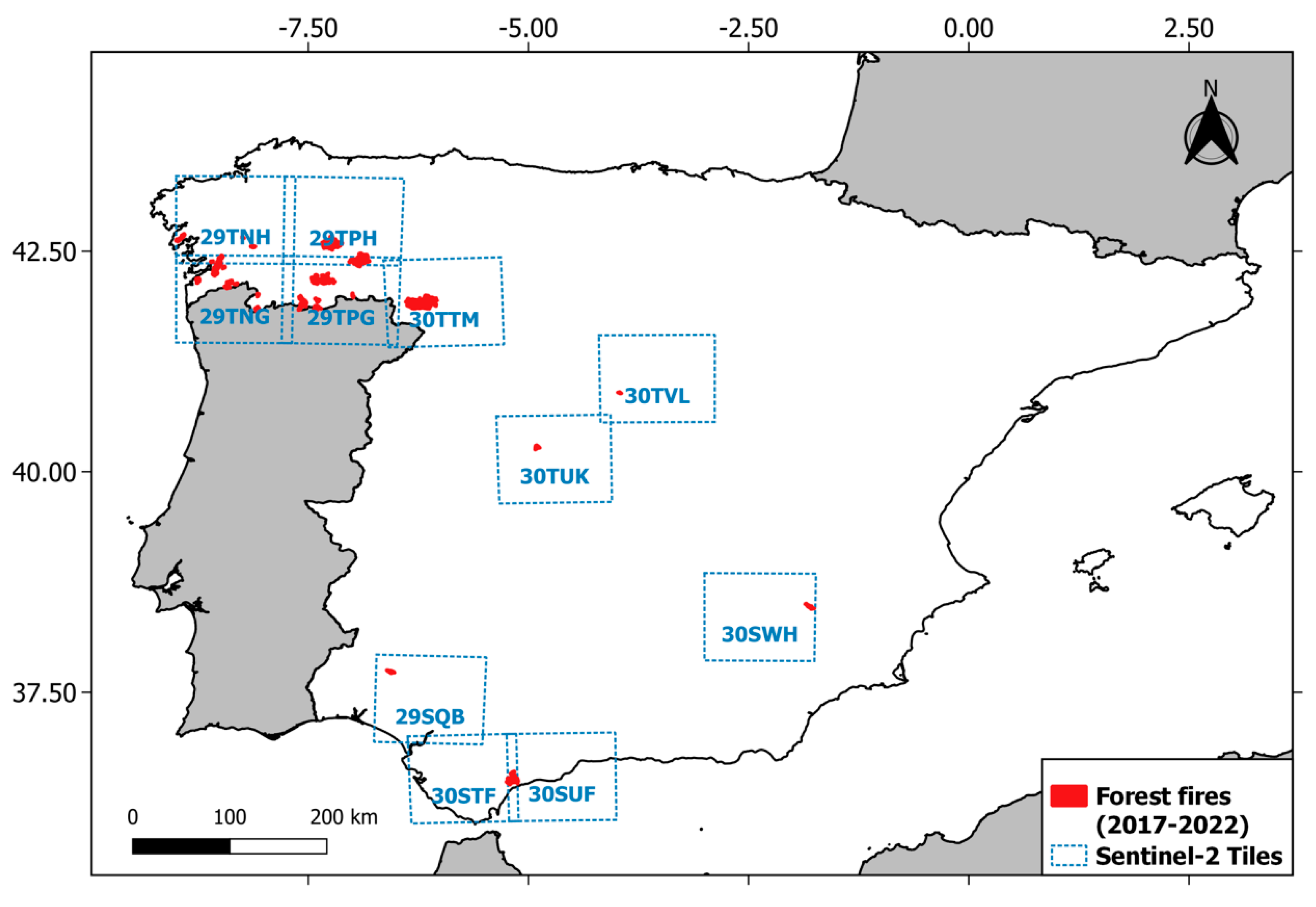
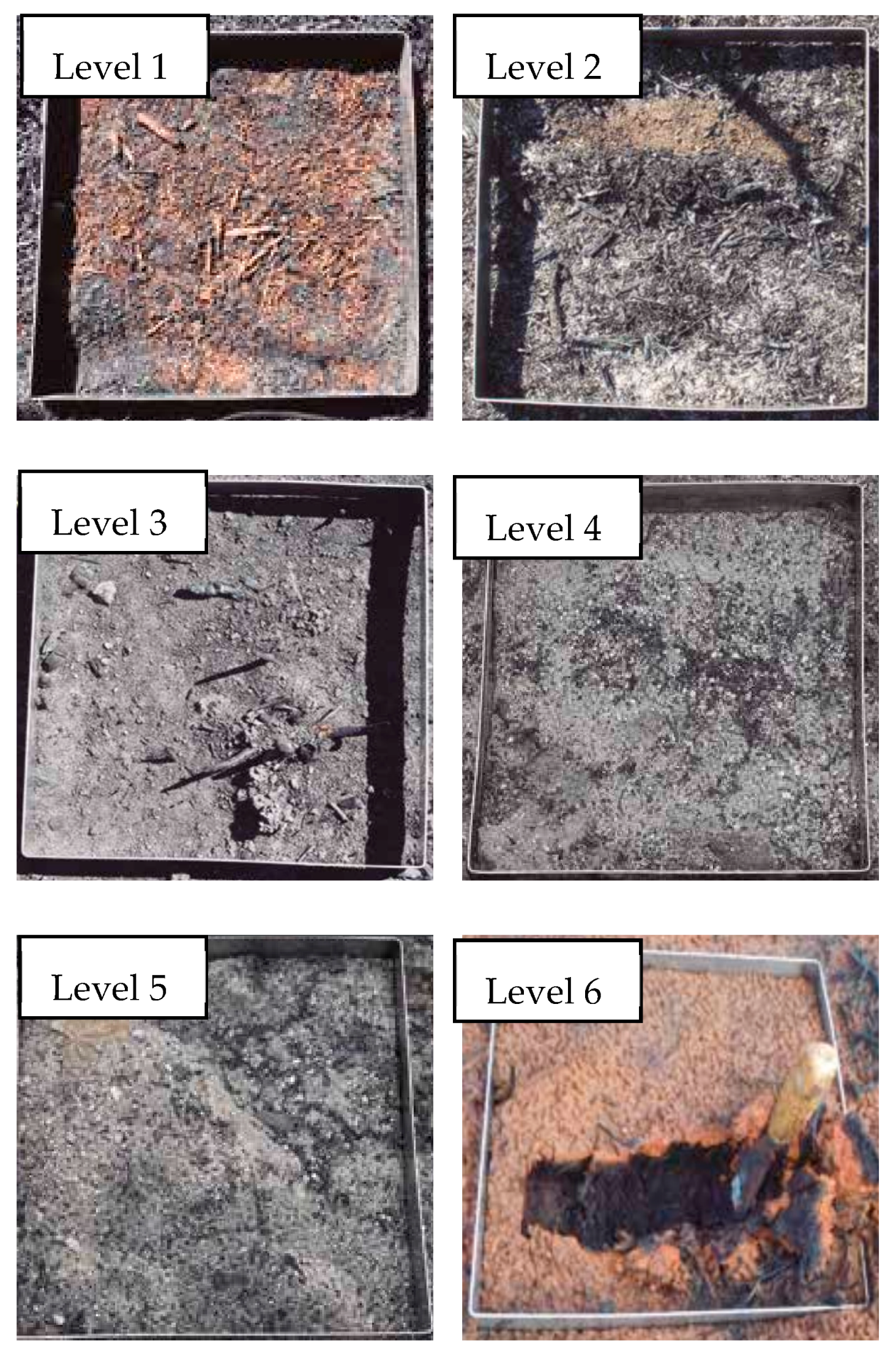
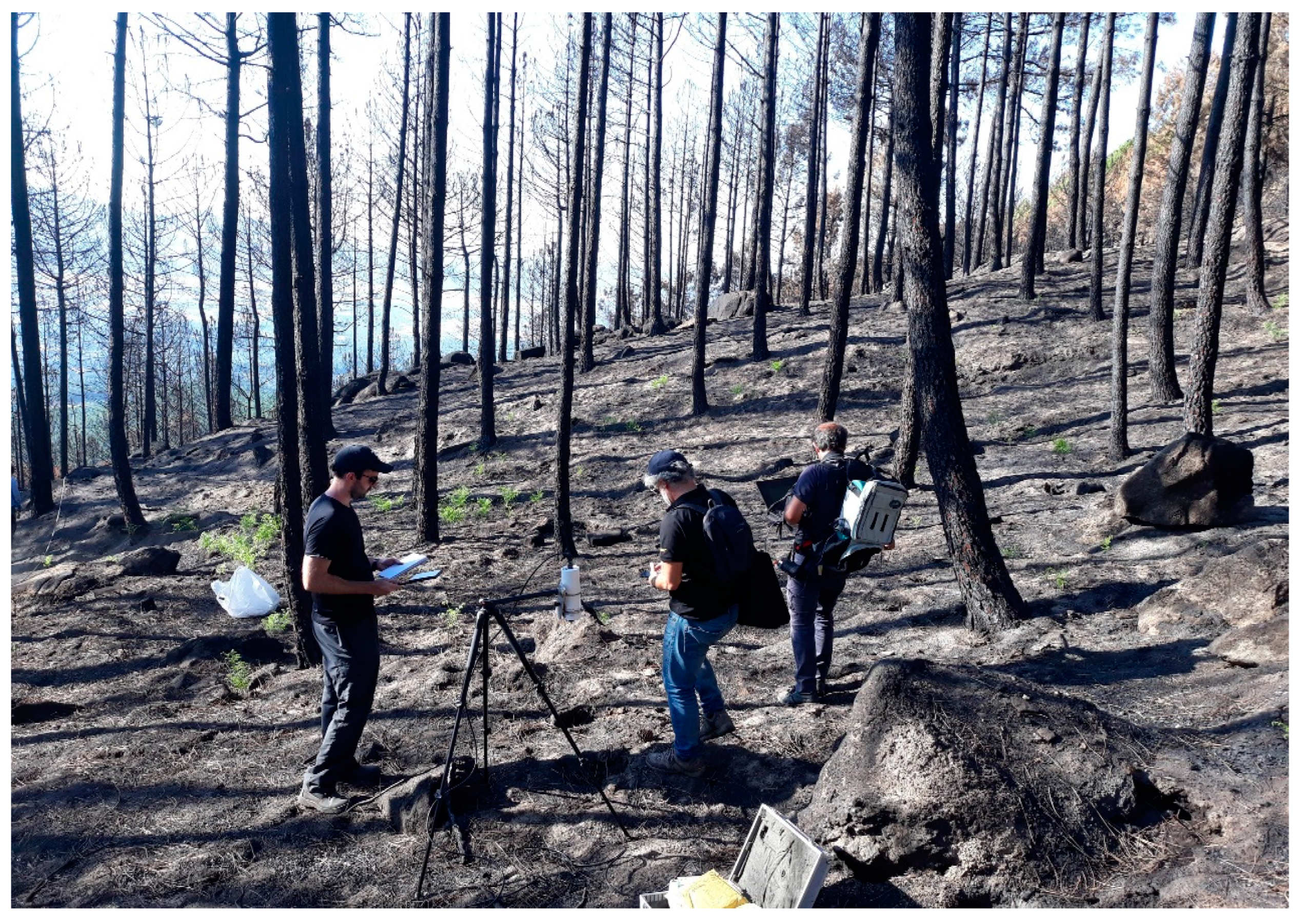

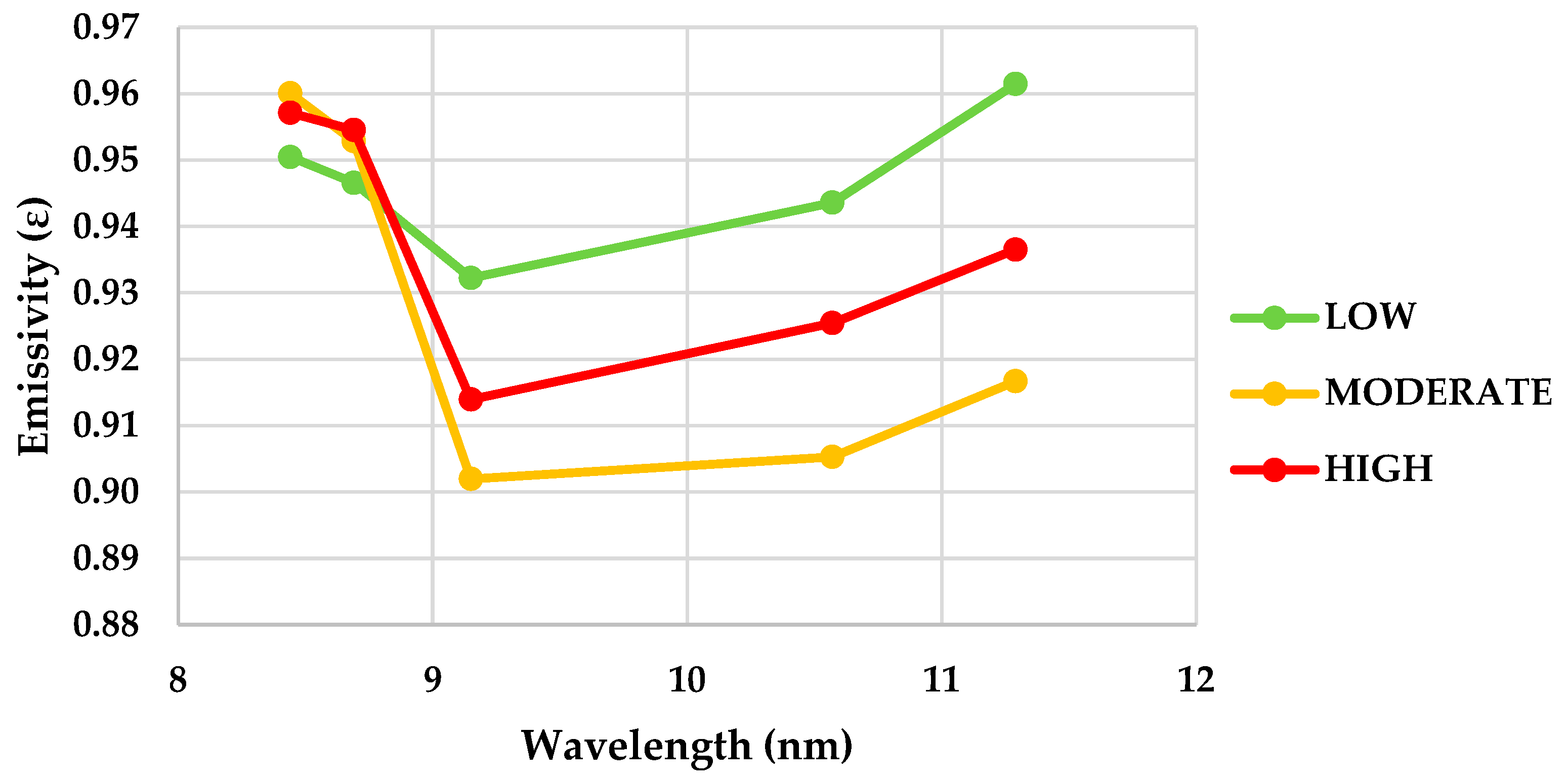
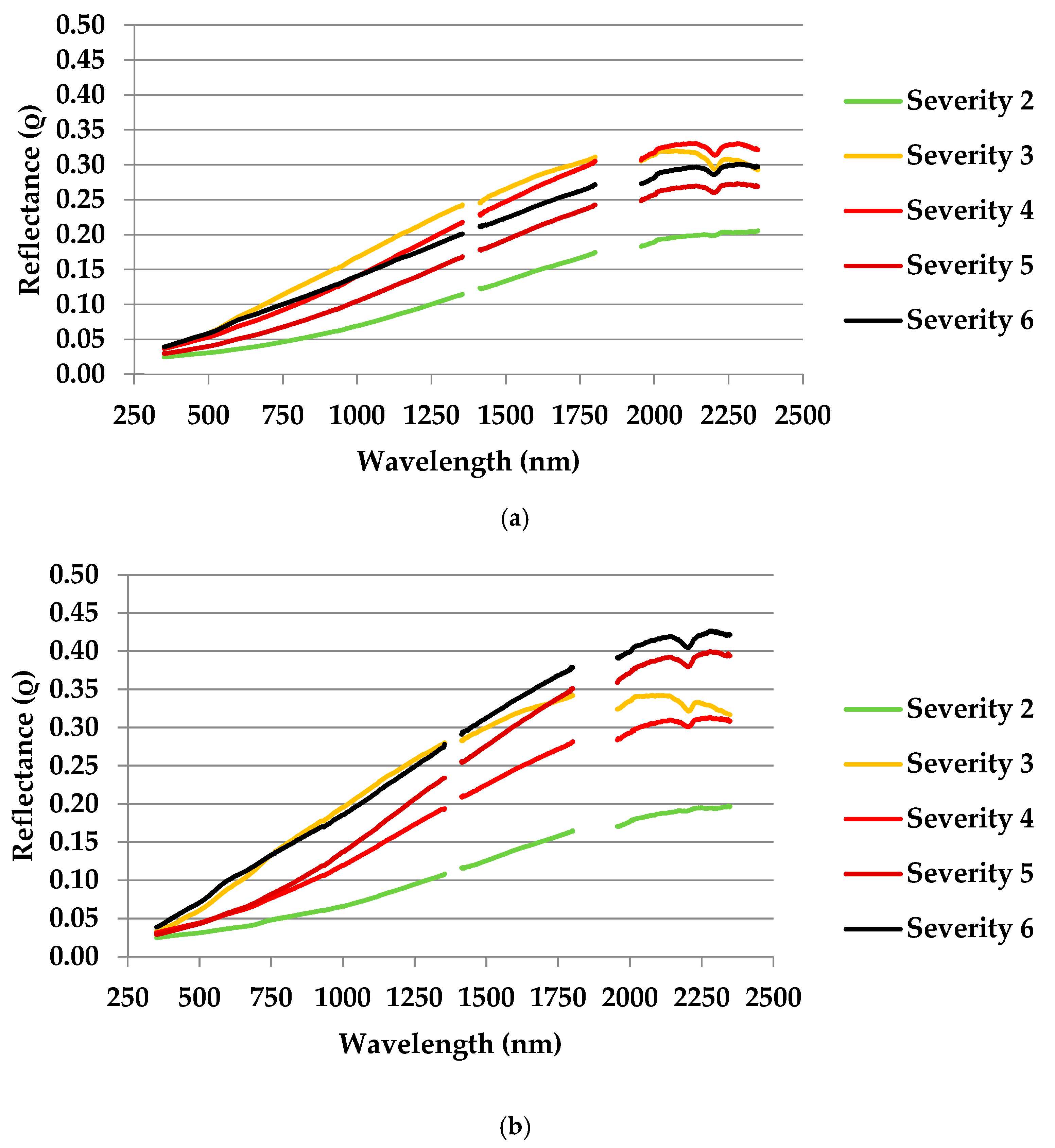


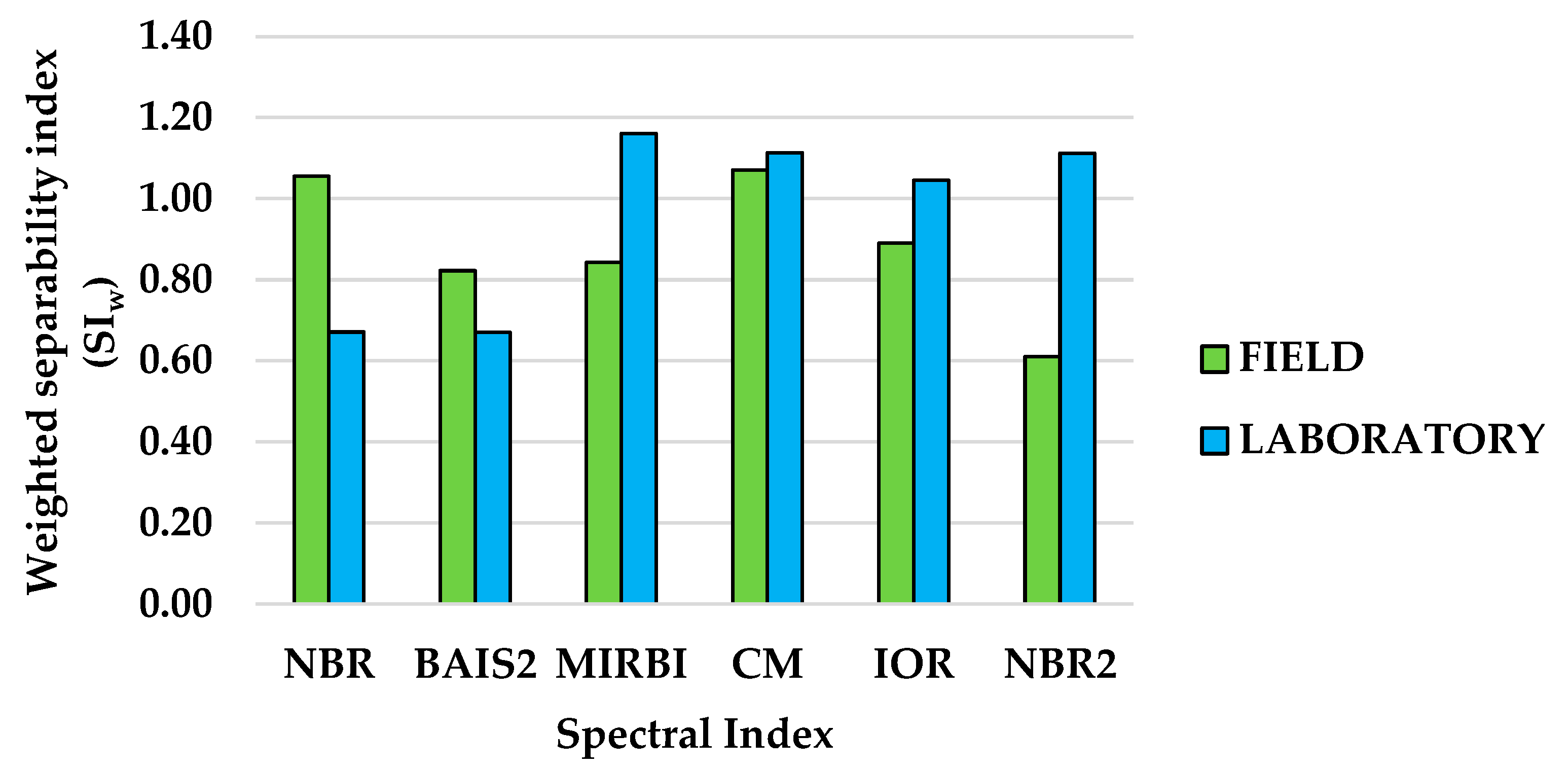
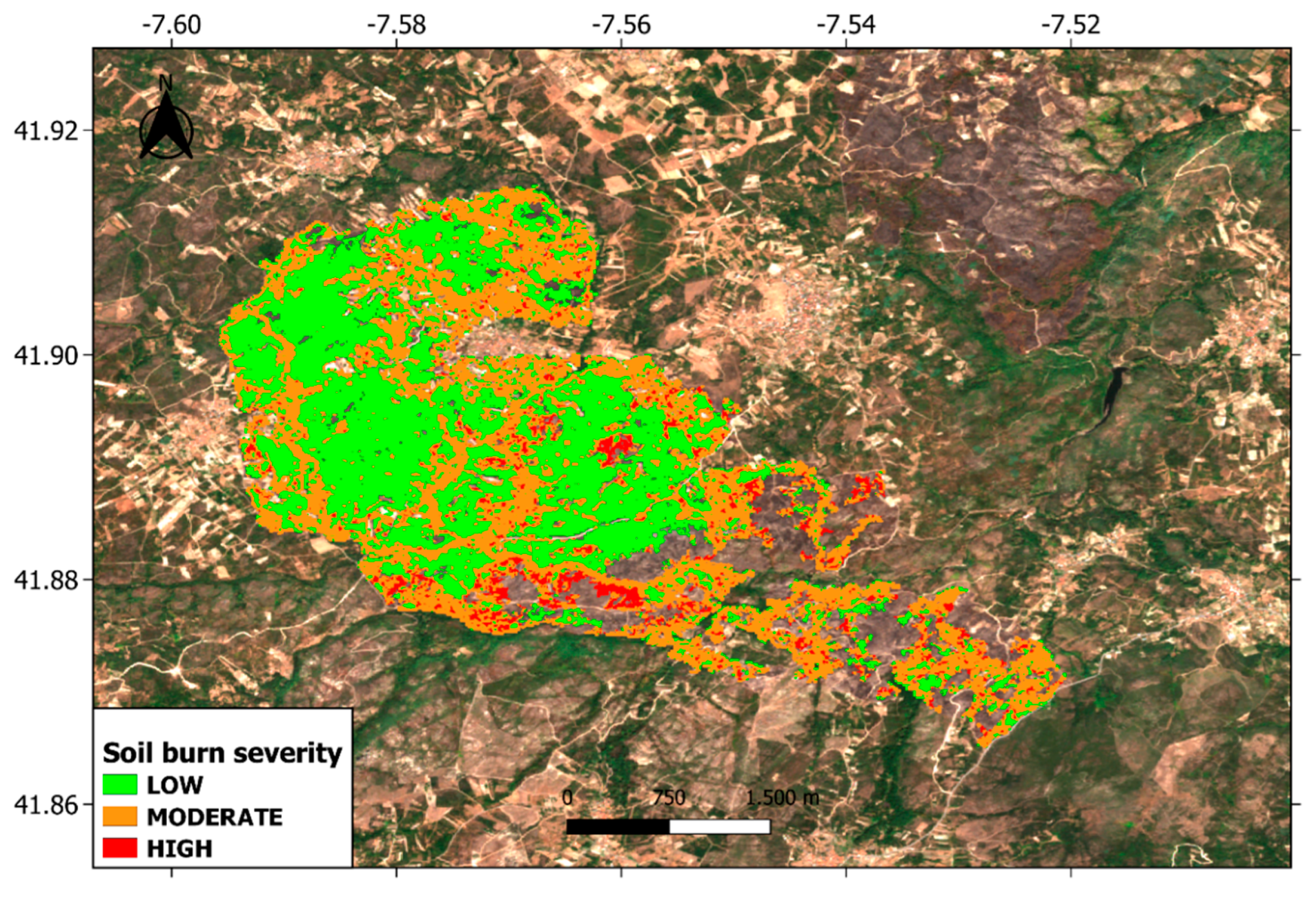
| Community | Place Name | Forest Fire Extinction Date | Field Campaign Date | Soil Burn Severity Plots | ||
|---|---|---|---|---|---|---|
| Low | Moderate | High | ||||
| Andalucía | Nerva | 2 August 2018 | 4 October 2018 | 2 | 7 | - |
| Estepona | 12 September 2021 | 21 October 2021 22 October 2021 | 2 | 5 | - | |
| Castilla La Mancha | Hellín | 25 July 2021 | 18 August 2021 19 August 2021 | 4 | 7 | - |
| Castilla y León | Real Sitio de San Ildefonso | 4 August 2019 | 5 September 2019 | 4 | 6 | 2 |
| Pedro Bernardo | 28 June 2019 | 2 August 2019 | 1 | 3 | - | |
| Zamora | 24 June 2022 | 15 July 2022 | 31 | - | 5 | |
| Galicia | Silleda | 15 October 2017 | 14 November 2017 | 2 | 6 | 2 |
| Nigrán | 15 October 2017 | 14 November 2017 | - | 1 | - | |
| Soutomaior | 15 October 2017 | 14 November 2017 | 6 | 17 | 3 | |
| Fornelos de Montes | 16 October 2017 | 14 November 2017 | 3 | 5 | - | |
| As Neves | 15 October 2017 | 14 November 2017 | 2 | 14 | - | |
| Flariz | 24 July 2020 | 31 July 2020 27 August 2020 | 13 | 9 | 1 | |
| San Millao | 29 July 2020 | 4 August 2020 3 September 2020 10 September 2020 | 12 | 16 | 1 | |
| Verín 1 | 22 July 2020 4 August 2022 | 9 September 2020 22 August 2022 23 August 2022 | 12 | 5 | - | |
| Lobios | 12 September 2020 | 21 September 2020 28 September 2020 | 11 | 5 | 3 | |
| Vilariño | 13 September 2020 | 22 September 2020 | 5 | 3 | 3 | |
| Cualedro | 13 September 2020 | 25 September 2020 26 September 2020 | 6 | 3 | - | |
| Chandrexa | 13 September 2020 | 29 September 2020 | 2 | 3 | - | |
| Cernado | 14 September 2020 | 29 September 2020 | 3 | - | 2 | |
| Cadavos | 14 September 2020 | 30 September 2020 | 1 | 2 | 3 | |
| Arbo | 31 July 2022 | 22 August 2022 | 3 | 1 | 2 | |
| Baltar | 6 August 2022 | 16 August 2022 | 5 | - | - | |
| Boiro | 6 August 2022 | 10 August 2022 12 August 2022 | 16 | - | 5 | |
| Carballeda de Valdeorras | 22 July 2022 | 2 August 2022 3 August 2022 | 27 | 56 | 3 | |
| Folgoso do Courel | 23 July 2022 | 27 July 2022 28 July 2022 29 July 2022 4 August 2022 | 47 | 12 | 30 | |
| Irixo | 11 August 2022 | 29 August 2022 | 3 | - | 4 | |
| Laza-Chandrexa | 15 August 2022 | 18 August 2022 | 3 | - | - | |
| Lobeira | 26 August 2022 | 6 September 2022 | 3 | - | - | |
| Oimbra-Rabal | 21 July 2022 | 18 August 2022 23 August 2022 | 11 | 1 | 2 | |
| Oimbra-Videferre | 19 July 2022 | 23 August 2022 | 3 | - | - | |
| Vilariño de Conso | 24 July 2022 | 18 August 2022 | 2 | - | - | |
| Global | - | - | 245 | 187 | 71 | |
| Sentinel-2 Bands | Central Wavelength (μm) | Resolution (m) |
|---|---|---|
| B1—Coastal aerosol | 0.433 | 60 |
| B2—Blue | 0.490 | 10 |
| B3—Green | 0.560 | 10 |
| Band 4—Red | 0.665 | 10 |
| B5—Vegetation Red Edge | 0.705 | 20 |
| B6—Vegetation Red Edge | 0.740 | 20 |
| B7—Vegetation Red Edge | 0.783 | 20 |
| B8—NIR | 0.842 | 10 |
| B8A—Vegetation Red Edge | 0.865 | 20 |
| B9—Water Vapor | 0.945 | 60 |
| B10—SWIR—Cirrus | 1.375 | 60 |
| B11—SWIR 1 | 1.610 | 20 |
| B12—SWIR 2 | 2.190 | 20 |
| Spectral Index | Algorithm | Reference |
|---|---|---|
| Normalized Burn Ratio (NBR) | [60] | |
| Normalized Burn Ratio 2 (NBR2) | [33] | |
| Mid-Infrared Burn Index (MIRBI) | [31] | |
| Burned Area Index for Sentinel-2 (BAIS2) | [20] | |
| Clay Ratio (CR) | [61] | |
| Iron Oxide Ratio (IOR) | [62] |
| Scenario | Spectral Index | Optimal Thresholds | ||
|---|---|---|---|---|
| Low | Moderate | High | ||
| Field | NBR | NBR < −0.55 | NBR > −0.49 | −0.49 ≥ NBR ≥ −0.55 |
| CM | CM < 0.74 | CM > 0.85 | 0.85 ≥ CM ≥ 0.74 | |
| Laboratory | IOR | IOR < 1.39 | IOR > 1.69 | 1.69 ≥ IOR ≥ 1.39 |
| CM | CM < 0.74 | CM > 0.89 | 0.89 ≥ CM ≥ 0.74 | |
| NBR2 | NBR2 < −0.15 | NBR2 > −0.06 | −0.06 ≥ NBR2 ≥ −0.15 | |
| MIRBI | −0.31 ≥ MIRBI ≥ −0.62 | MIRBI > −0.31 | MIRBI < −0.62 | |
| Scenario | Spectral Index | Sensitivity | Specificity | Mean (Sensitivity and Specificity) | ||||||
|---|---|---|---|---|---|---|---|---|---|---|
| L | M | H | L | M | H | L | M | H | ||
| Field | NBR | 0.55 | 0.83 | 0.24 | 0.91 | 0.48 | 0.97 | 0.73 | 0.66 | 0.61 |
| CM | 0.46 | 0.82 | 0.34 | 1.00 | 0.54 | 0.84 | 0.73 | 0.68 | 0.59 | |
| Laboratory | IOR | 0.83 | 0.52 | 0.70 | 0.78 | 0.92 | 0.84 | 0.81 | 0.72 | 0.77 |
| CM | 0.46 | 0.67 | 0.59 | 1.00 | 0.66 | 0.73 | 0.73 | 0.67 | 0.66 | |
| NBR2 | 0.46 | 0.71 | 0.56 | 0.98 | 0.64 | 0.77 | 0.72 | 0.68 | 0.67 | |
| MIRBI | 0.57 | 0.81 | 0.00 | 0.87 | 0.46 | 0.97 | 0.72 | 0.64 | 0.49 | |
| Scenario | Spectral Index | Accuracy (ACC) | Balanced Accuracy (BACC) | F1-Score (F1) | Cohen’s Kappa index (k) |
|---|---|---|---|---|---|
| Field | NBR | 0.61 | 0.66 | 0.54 | 0.35 |
| CM | 0.58 | 0.66 | 0.52 | 0.34 | |
| Laboratory | IOR | 0.71 | 0.76 | 0.63 | 0.50 |
| CM | 0.56 | 0.68 | 0.54 | 0.35 | |
| NBR2 | 0.57 | 0.69 | 0.54 | 0.36 | |
| MIRBI | 0.57 | 0.61 | 0.42 | 0.28 |
Disclaimer/Publisher’s Note: The statements, opinions and data contained in all publications are solely those of the individual author(s) and contributor(s) and not of MDPI and/or the editor(s). MDPI and/or the editor(s) disclaim responsibility for any injury to people or property resulting from any ideas, methods, instructions or products referred to in the content. |
© 2024 by the authors. Licensee MDPI, Basel, Switzerland. This article is an open access article distributed under the terms and conditions of the Creative Commons Attribution (CC BY) license (https://creativecommons.org/licenses/by/4.0/).
Share and Cite
Llorens, R.; Sobrino, J.A.; Fernández, C.; Fernández-Alonso, J.M.; Vega, J.A. Soil Burn Severity Assessment Using Sentinel-2 and Radiometric Measurements. Fire 2024, 7, 487. https://doi.org/10.3390/fire7120487
Llorens R, Sobrino JA, Fernández C, Fernández-Alonso JM, Vega JA. Soil Burn Severity Assessment Using Sentinel-2 and Radiometric Measurements. Fire. 2024; 7(12):487. https://doi.org/10.3390/fire7120487
Chicago/Turabian StyleLlorens, Rafael, José Antonio Sobrino, Cristina Fernández, José M. Fernández-Alonso, and José Antonio Vega. 2024. "Soil Burn Severity Assessment Using Sentinel-2 and Radiometric Measurements" Fire 7, no. 12: 487. https://doi.org/10.3390/fire7120487
APA StyleLlorens, R., Sobrino, J. A., Fernández, C., Fernández-Alonso, J. M., & Vega, J. A. (2024). Soil Burn Severity Assessment Using Sentinel-2 and Radiometric Measurements. Fire, 7(12), 487. https://doi.org/10.3390/fire7120487







